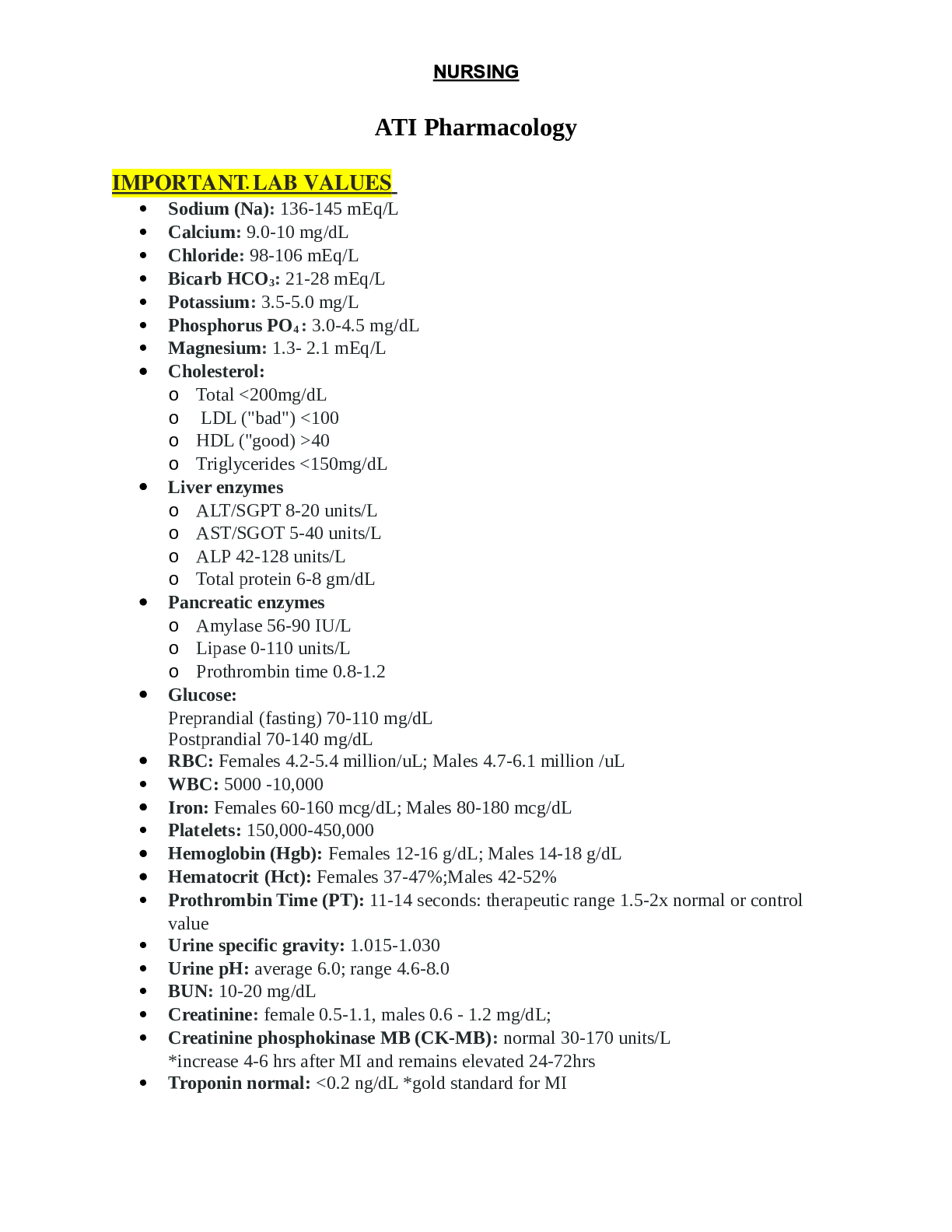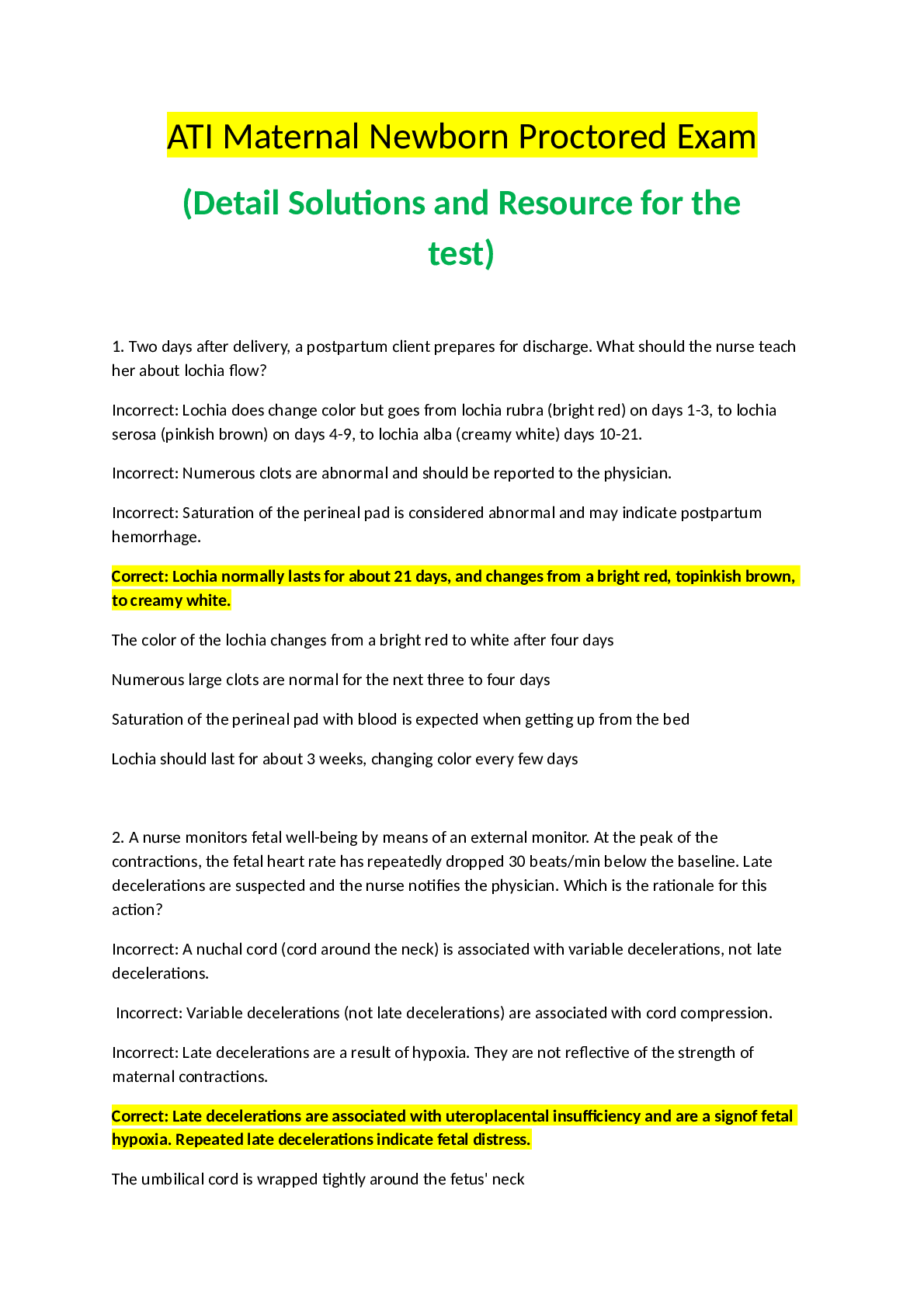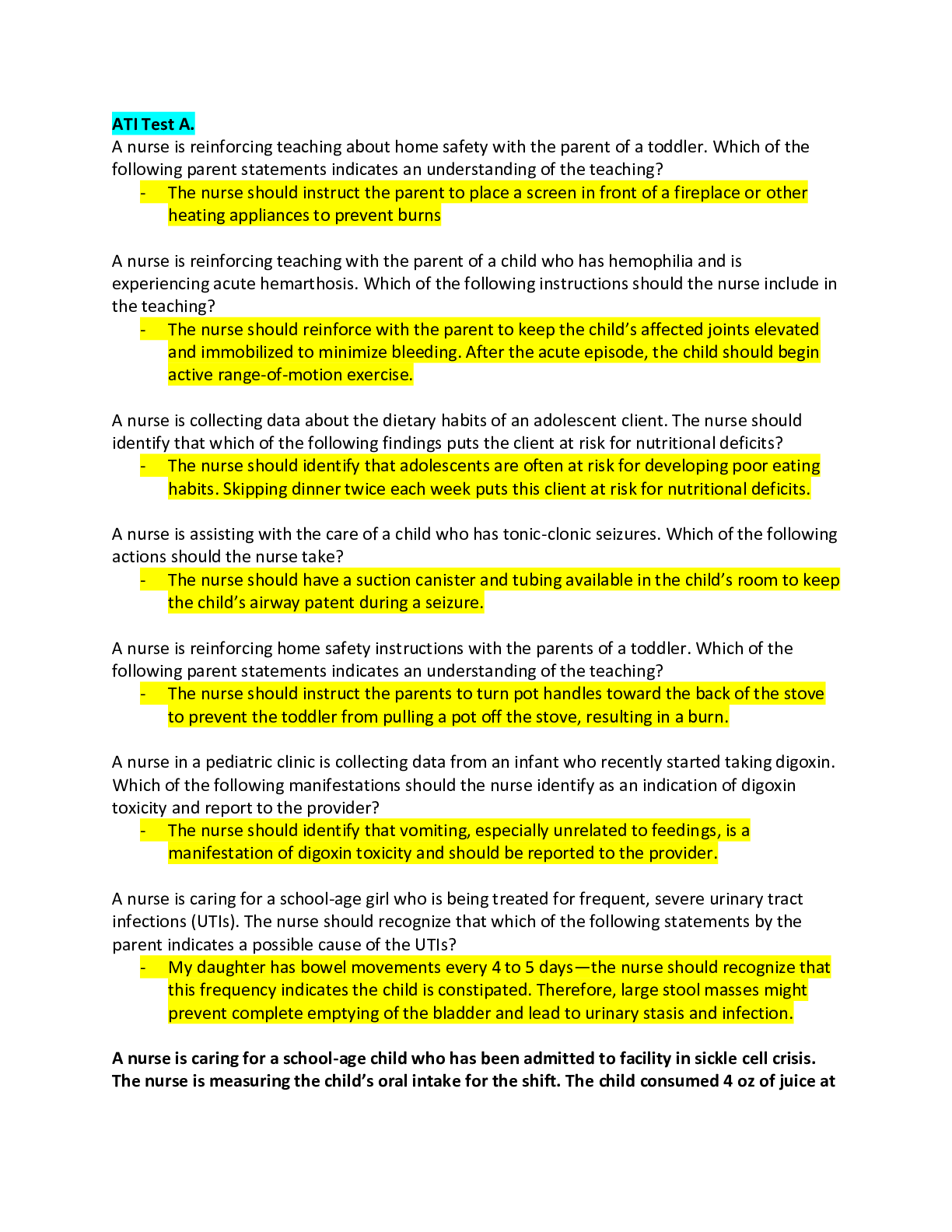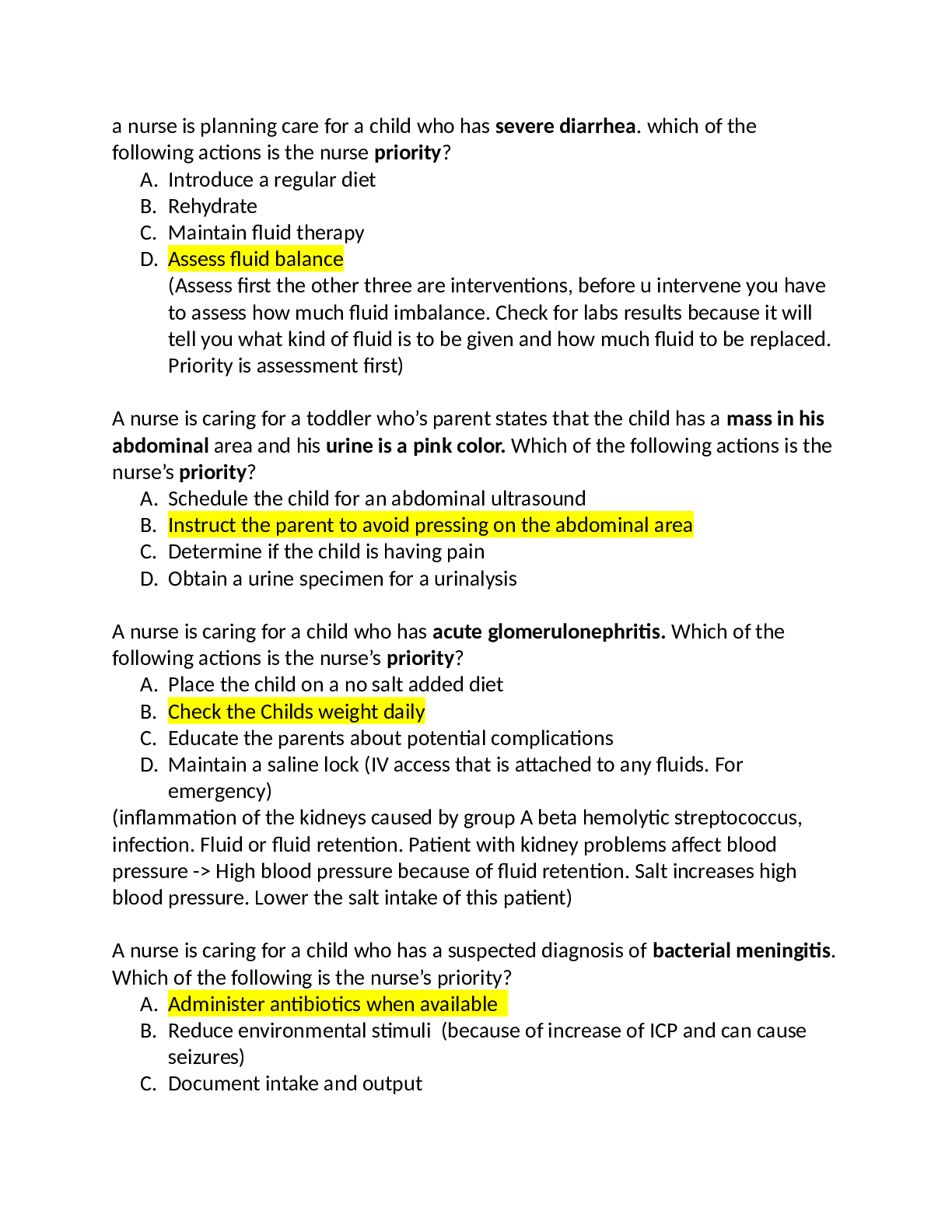Pharmacology > QUESTIONS and ANSWERS > ATI Pharmacology Proctored 2 (All)
ATI Pharmacology Proctored 2
Document Content and Description Below
ATI Pharmacology Proctored 2 ATI Pharmacology IMPORTANT LAB VALUES • Sodium (Na): • Calcium: • Chloride: • Bicarb HCO3: • Potassium: • Phosphorus PO4 : • Magnesium: �... �� Cholesterol: - Safe Medication Administration and Error Reduction: Reviewing a Medication Administration Record (RN QSEN - Teamwork and Collaboration, Active Learning Template - Nursing Skill, RM Pharm RN 7.0 Ch. 2) Chapter 12 - Substance Use Disorders: Therapeutic effect of chlordiazepoxide (Ch. 12 pg.85) - Substance Use Disorders: Smoking cessation using bupropion (Ch. 12 pg. 87) - Substance Use Disorders: Treatment for Cocaine Toxicity (Active Learning Template - System Disorder, RM Pharm RN 7.0 Ch. 12) Chapter 13 - Chronic Neurologic Disorders: Adverse effects of neostigmine (Ch. 13 pg. 91) - Chronic Neurologic Disorders: Medications that interact with Carbamazepine (Ch. 13 pg. 99) - . - Chronic Neurologic Disorders: Adverse Effects of Phenytoin (RN QSEN - Safety, Active Learning Template - Medication, RM Pharm RN 7.0 Ch. 13) - Miscellaneous Central Nervous System Medications: Treating Malignant Hyperthermia (Active Learning Template - Medication, RM Pharm RN 7.0 Ch. 15) . - Airflow Disorders: Therapeutic Action of Montelukast (Active Learning Template - Medication, RM Pharm RN 7.0 Ch. 17) - Upper Respiratory Disorders: Client Teaching Prior to Allergy Testing (Active Learning Template - Medication, RM Pharm RN 7.0 Ch. 18) . - Medications Affecting Blood Pressure: Titrating Continuous Nitroprusside Infusion (RN QSEN - Safety, Active Learning Template - Medication, RM Pharm RN 7.0 Ch. 20) 1) Angina Chapter 22 (pg. 169) Self-administration of nitroglycerine patch (pg. 170) Client teaching for a new prescription of sublingual nitroglycerin PROTOTYPE: Nitroglycerin (NTG) Adverse Effects: Headache: Orthostatic hypotension: - . Reflex Tachycardia: Tolerance: Contraindications/ Precautions: Nursing evaluation of medication effectiveness: - In chronic stable exertional angina, nitroglycerin dilates veins and decreases venous return (preload), which decreases cardiac oxygen demand. - Use this rapid‑acting nitrate at the first indication of chest pain. Do not wait until pain is severe. - Use prior to activity that is known to cause chest pain, such as climbing a flight of stairs. - Place the tablet under the tongue and allow it to dissolve - Store tablets in original bottles, and in a cool, dark place. - Medications Affecting Cardiac Rhythm: Ventricular Dysrhythmia (Active Learning Template - Medication, RM Pharm RN 7.0 Ch. 23) sinus bradycardia, and heart failure. Medications Affecting Coagulation (Chapter 25 page 191) Administering Heparin (pg. 193) Laboratory values to report to the provider PROTOTYPE: Heparin Adverse Effects: Hemorrhage secondary to heparin overdose: Heparin induced thrombocytopenia Interventions: - Evidenced by low platelet count and increased development of thrombi: mediated by antibody development (white clot syndrome) Toxicity/overdose: Enoxaparin: Hemorrhage: Neurologic damage from hematoma formed during spinal or epidural anesthesia: Thrombocytopenia Interventions: - Toxicity/ Overdose Fondaparinux: Contraindications/Precautions: Interactions: Nursing Evaluation of Medication Effectiveness: Oral Anticoagulants Adverse Effects: Hemorrhage Hepatitis: Toxicity/ Overdose: Contraindications/ Precautions: Interactions: Concurrent use of heparin, aspirin, acetaminophen, glucocorticoids, sulfonamides, and parenteral cephalosporins increases effects of warfarin, which increases the risk for bleeding. Concurrent use of phenobarbital, carbamazepine, phenytoin, oral contraceptives, and vitamin K decreases anticoagulant effects. Foods high in vitamin K, such as dark green leafy vegetables (lettuce, cooked spinach), cabbage, broccoli, Brussels sprouts, mayonnaise, and canola and soybean oil, can decrease anticoagulant effects with excessive intake. Multiple other medications interact with warfarin. Nursing Administer: . Laboratory Values: Adverse effects of Clopidogrel: Bleeding: Growth factors (chapter 26 pg. 201) Evaluating Client response PROTOTYPE: Epoetin Alfa, erythropoietin Adverse effects: Hypertension: Secondary to elevation in hematocrit level. Risk for a thrombic event: Such as myocardial infraction or stroke if the client has a Hgb of 11/g/dL or higher, or an increase of more than 1g/dL in 2 weeks. Seizures can also occur with a too-rapid rise in the blood counts. Deep-vein thrombosis: . Headache and body aches:. Contraindications/ Precautions: - . Nursing evaluation of medication effectiveness: Peptic Ulcer Disease (Chapter 28 pg. 215) Client teaching about sucralfate (pg. 216) Teaching about Ranitidine Histamine 2-receptor antagonists: PROTOTYPE: Ranitidine (-ine) Cimetidine Adverse Effects: Blocked androgen receptors CNS Effects (lethargy, depression, confusion): Ranitidine Adverse Effects: . Famotidine Adverse Effects: . Contraindications/ Precautions: Interactions: Cimetidine can inhibit medication-metabolizing enzymes and thus increase the levels of warfarin, phenytoin, theophylline, and lidocaine. Concurrent use of antacids can decrease absorption of histamine2-receptor antagonists. Proton pump inhibitor: (-prazole) PROTOTYPE: Omeprazole : : Pneumonia Osteoporosis and fractures - Rebound acid hypersecretion Hypomagnesemia Contraindications/ Precautions: Interactions: Nursing administration: - Mucosal Protectant: PROTOTYPE: Sucrasulfate Adverse effects: Constipation . Contraindications/ Precautions: - . Interactions: Sucralfate can interfere with the absorption of phenytoin, digoxin, warfarin, and ciprofloxacin. . Nursing administration: - Antacids: PROTOTYPE: Aluminum hydroxide Adverse effects: Constipation, diarrhea - Aluminum and calcium compounds: constipation - Magnesium compounds: diarrhea . Fluid retention - Antacids containing sodium can result in fluid retention. - Teach clients who have hypertension or heart failure to avoid antacids that contain sodium. Hypophosphatemia, hypomagnesemia - Possible effects of aluminum hydroxide. -. Toxicity, hypermagnesemia - Magnesium compounds can lead to toxicity and hypermagnesemia in clients who have impaired kidney function. - - ………………………………………………continued………………………………. [Show More]
Last updated: 2 years ago
Preview 1 out of 21 pages

Buy this document to get the full access instantly
Instant Download Access after purchase
Buy NowInstant download
We Accept:

Reviews( 0 )
$14.00
Can't find what you want? Try our AI powered Search
Document information
Connected school, study & course
About the document
Uploaded On
Jan 12, 2021
Number of pages
21
Written in
Additional information
This document has been written for:
Uploaded
Jan 12, 2021
Downloads
0
Views
97





.png)

















 – Chamberlain College of Nursing.png)

